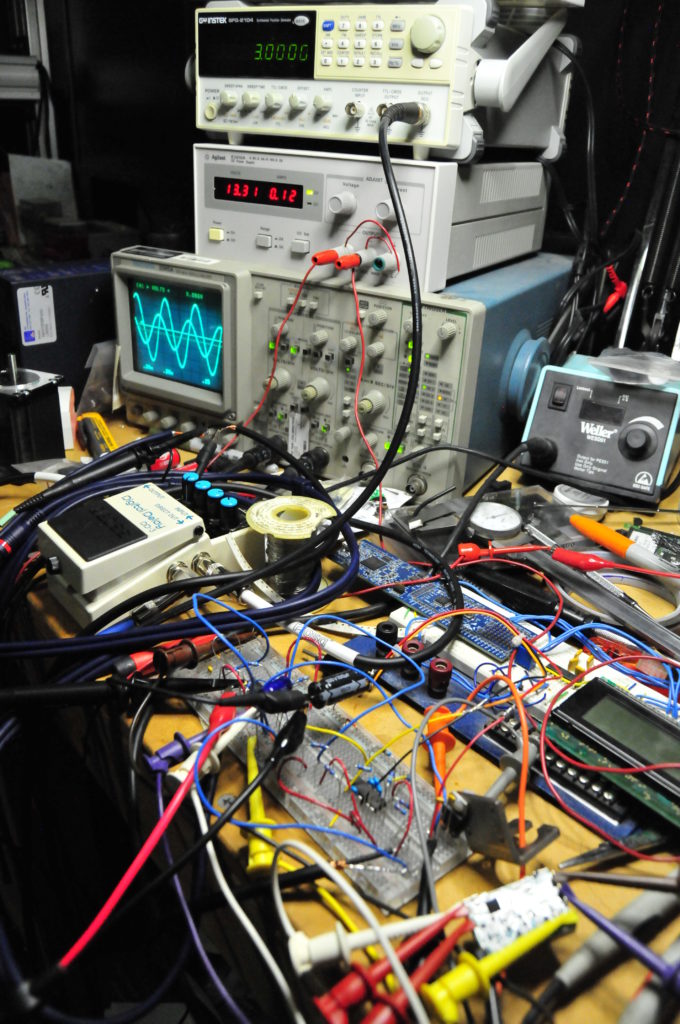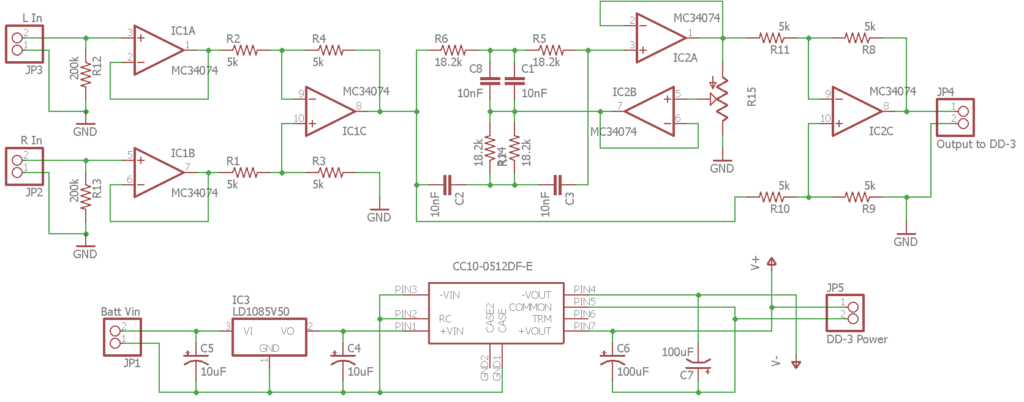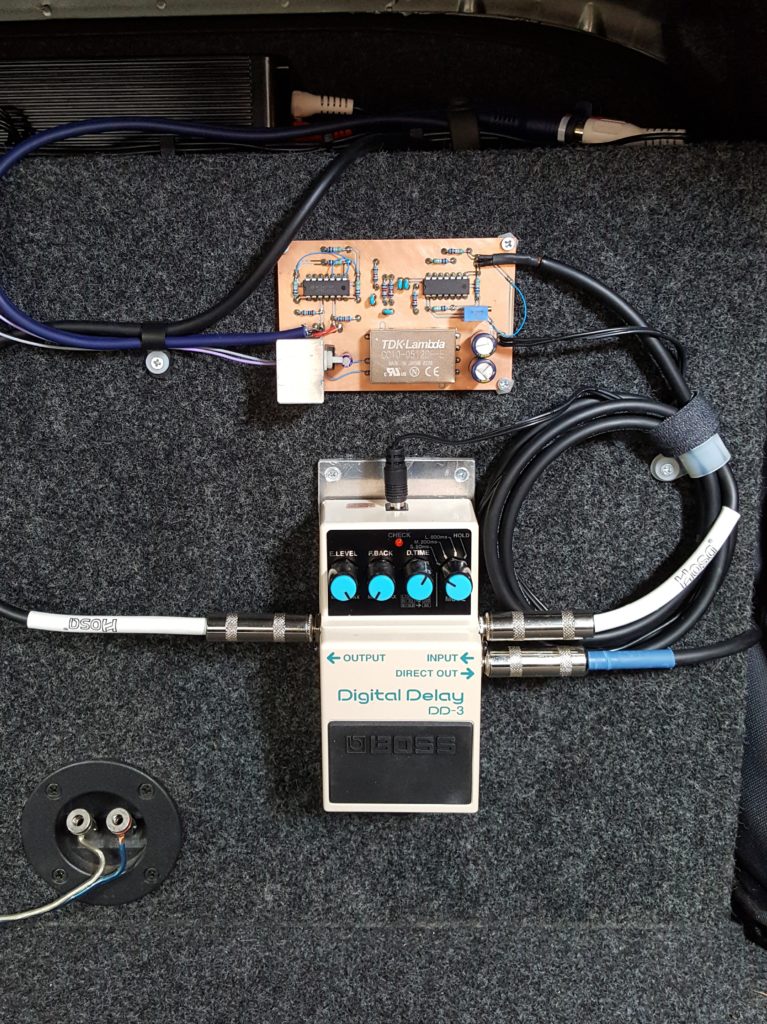Automotive rear fill “surround sound” with Boss DD-3
Lately I’ve been experimenting with rear fill in my car. Similar to matrix “surround sound”, but not a discrete multichannel system where sounds are meant to originate from the sides or rear; rear fill is intended to improve the front soundstage in a car which is normally pretty poor due to proximity to the left and right speakers as well as cabin reflections. Specifically this is implemented as a delayed, bandwidth limited, mono L-R difference signal for the rear speakers.
There is quite a bit of variance in implementation of this method, such as amount of delay, filter corner frequencies and Q, etc. After spending much time reading and not being confident picking some values, I decided to build a fully variable test setup.

Breadboard and bench test so I don’t burn up my stereo/amps, also verifying proper operation from the DD-3.
To handle bandpass filtering and create a mono L-R difference signal I started with two op-amps to first buffer the left and right signals and then another op-amp follows as a differential amplifier to create the mono difference signal. This signal is then fed to a twin T cell notch filter with constant in-band gain but adjustable Q to provide variable bandwidth around a center frequency I chose, about 925Hz. The bandwidth of the filter is adjusted by feedback through a potentiometer without affecting gain so relative cutoff frequencies can be changed in real time. To turn the notch filter into a bandpass filter the output of the notch filter is compared to the input by a difference amplifier.
Probably the most important part of this is adding a delay. The effect relies on psychoacoustics to trick your brain into thinking you are in a bigger space since all reflections in a car are early reflections. Due to the speed of sound there just isn’t time in a car to produce late reflections which give your brain a sense of “space”. These reflections are different from echoes which the brain interprets as a separate event. The Haas effect (or precedence effect) defines that if a sound and its reflection arrive at the listener within a sufficiently short period of time the listener will perceive them as the same event. The period of time is different for different sounds, but is generally accepted to be between 20 and 30 milliseconds. The goal with rear fill is to add enough delay to simulate a larger room with later reflections but not produce an echo.
I bought a Boss DD-3 digital delay guitar pedal for this because it is perfect for the test. You can isolate just the delay signal, the delay is continuously adjustable, and one of the adjustment ranges is 12.5-50mS (which is something the MiniDSP and PT2399 can’t do). It has defeatable feedback so there will be no echo and it is digital so the signal should be accurately reproduced. It can also be instantly bypassed with the footswitch which is essential in identifying whether a change is better or worse.
The only problem with the DD-3 is it is very sensitive to power supply noise. I originally had the pedal’s power supply using a common power ground but there was a lot of ignition noise being coupled to the signal. The CC10 power supply I used was perfect since it can provide an isolated ground, just don’t connect input power ground to output common.
After a few hours of tweaking and listening, here are my results. The delay effect is really incredible. Without changing volume, just selecting and deselecting the delay produces a very noticeable change in the soundstage. Without the delay the sound feels close to you, sort of in a semicircle and I am aware of some out of phase frequencies (that weird pressure in your ears) probably because of window reflections. The speakers are easy to localize which are in factory locations. With the delay turned on, the stage instantly moves out and slightly up, and instead of feeling like its kind of curved around you the stage is now straight and out in front like a real stage would be. Turn the delay off and the corners drag in again, the speaker becomes more localized, the width of the stage shrinks and the out of phase effect you get when you move your head comes back.
Adjusting the amount of delay changes how much some things are in front of you or behind you. This is recording dependent. On recordings with a lot of independent L and R information, turning up the delay makes these sounds seem to come from all around you and more delay just intensifies this effect until you actually start thinking some sounds are coming from directly behind you. At this point though (about 50mS) some tracks develop echo, mainly if they have a lot of drums. Turning on and off the delay at this high setting (no rear volume change!) makes it seem like you’re at a show and someone is opening and closing the doors behind you. Another way to describe it is like sitting in a chair and someone is moving a big board or sign in and out behind you. The ambience just disappears without the delay.
I’ve settled on a delay of 25-30mS. I feel like this is a good balance for me and the music I like. Vocals, drums and instruments are up front but echo effects, ambient sounds, backup singers, etc seems to come from all around but not specifically behind you. Drum snares and cymbals don’t noticeably sound smeared or echo. You could run about 40mS of delay if you like to be really immersed (or for that big venue feel), or maybe 15mS if you like more of an “up-front” experience that still improves staging and reduces your perception of out of phase nulls. You can even turn your head and still get decent staging.
The other part is band limiting. Based on my experiments sitting in the car listening to different tracks and turning the Q knob back and forth I have concluded that band limiting is not critical. There is very little bass in the difference signal, so no problems there. Most of the information is in the midrange, which is why I defined my center frequency as ~1kHz. On the high end you want to avoid the hiss of cymbals since it sounds unnatural and draws your attention rearward. I would estimate that this is about 4-5k and up. If you have rear tweeters disconnect them or cover them up, you might get away without a low pass. If you have rear tweeters like in my car they are probably high and close to your head which makes them very easy to localize and ruins the effect. Use rear deck or low door mount woofers. I didn’t bridge my rear speakers since I did preamp level signal manipulation and let the diff amp drive the L and R amp signals together. I doubt individual speaker phase is going to matter at all so I didn’t mess with that.
Honestly I was surprised at how little rear signal is required. With the pot at minimum (maximum Q) There is literally only a few Hz passing on either side of the Fc. Just cracking the pot open a little bit brought the effect in, I’m guessing maybe a couple hundred Hz bandwidth at -3dB. The staging effect was present but some rear sounds were thin. This was a 10 turn pot and after about 2-3 turns there was very little noticeable difference to the effect. I left it at about half, which is roughly equivalent to a first order passive network (20dB/decade). If I had to design a fixed filter for this it would probably be 1kHz Fc with 1kHz bandwidth at 6db/octave rolloff, cheap and easy. And if you are considering buying expensive speakers/amps for this, don’t. The difference signal honestly sounds terrible and you purposely keep it quiet so that it’s not something you actively notice. Use the fader and try lots of different tracks until you find a setting where you don’t really hear it but it surprises you every now and then with an awesome echo or something. Good luck!
5 Comments to Automotive rear fill “surround sound” with Boss DD-3
Leave a Reply
Other Stuff
Recent Posts
- 6CY7 dual triode valve amplifier
- Air quality sensor (TVOC and eqCO2)
- Automotive rear fill “surround sound” with Boss DD-3
- Spring tester / weight scale
- Ducati 749/999 Tail Light
- Instruments for the GSXR
- Light pipe tail light for the GSXR
- M17x 6990m / 6970m overheating
- PAR / Spectrum analyzer
- Acrylic polishing and scratch removal
Archives
- May 2019 (2)
- April 2017 (3)
- October 2015 (1)
- May 2015 (1)
- March 2014 (2)
- December 2013 (1)
- July 2013 (1)
- November 2012 (1)
- October 2012 (4)
- September 2012 (1)
- August 2012 (3)
- June 2012 (1)
- March 2012 (1)
- February 2012 (1)
- January 2012 (1)
- October 2011 (3)
- July 2011 (1)
- June 2011 (3)
- May 2011 (2)
- April 2011 (1)
- December 2010 (1)
- August 2010 (1)
- July 2010 (3)
- April 2010 (2)
- March 2010 (2)
- January 2010 (2)
- December 2009 (2)
- October 2009 (2)
- September 2009 (1)
- August 2009 (15)


[…] [Josh] has a car, and wanted to improve the sound. In particular, the aim was to improve the sense of space felt when listening. A car is a relatively small space, and the driver sits in close proximity to the front speakers, so it’s difficult to get a good soundstage. […]
[…] [Josh] has a car, and wanted to improve the sound. In particular, the aim was to improve the sense of space felt when listening. A car is a relatively small space, and the driver sits in close proximity to the front speakers, so it’s difficult to get a good soundstage. […]
[…] [Josh] has a car, and wanted to improve the sound. In particular, the aim was to improve the sense of space felt when listening. A car is a relatively small space, and the driver sits in close proximity to the front speakers, so it’s difficult to get a good soundstage. […]
Hi!
I really like the idea to improve the Sound Quality in my car and your article is very nice!
One question I have: do you just play the modified signal on your rear Speakers or do you mix that Signal with the original Signal and play that mixture on your rear Speaker?
The rest of your Setting would be interesting (just to know) and how is Sound Quality in your car if you sit anywhere else but the Driver seat??
Greez!
Tom
I just play the delayed signal to the rear, but the Boss pedal will also allow you to use a mix. I might have to do a test and see which sounds better.
The sound quality for the front two seats is much improved, I don’t use the balance or time alignment anymore for improving the driver’s seat listening position. I haven’t sat in the back yet so I’m not sure about those seats but I’ll have to try it.